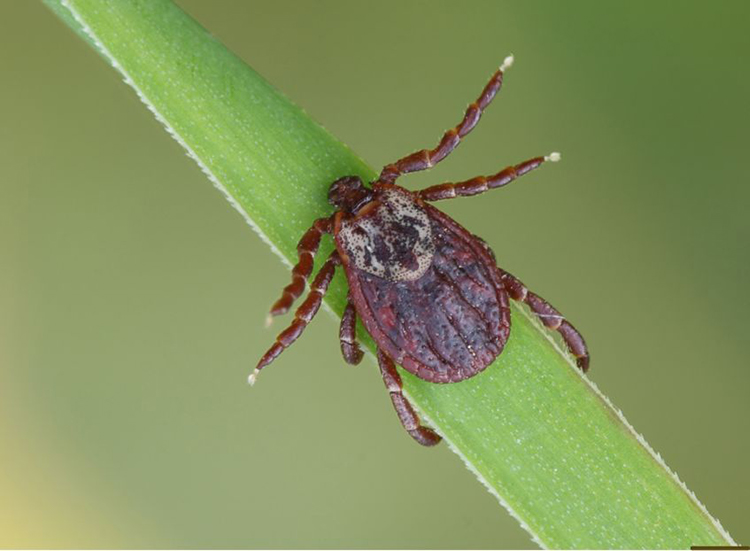Parasites in Dogs

Dogs can get many different types of parasites. Some live within their bodies, while others thrive on the outside. Some parasites can cause other diseases as well. Using preventatives consistently can help your dog avoid being infected with most parasites. Two of the most common external parasites are fleas and ticks, while the most common internal parasites are heartworms and intestinal parasites.
Ticks

There are many types of ticks in America, but the main types that affect dogs are the American dog tick, brown dog tick, lone star tick, and black-legged tick, commonly called the deer tick. Different species of ticks carry different diseases that they can transmit to dogs (and sometimes people). Ticks live throughout the country, but each species may only be found in certain regions
There are many types of tick-borne diseases dogs can be affected by, but three of the most common are the bacterial infections anaplasmosis, ehrlichiosis, and lyme disease. All of these are zoonotic diseases, meaning humans can be infected by these diseases too. They are also all prevalent in every state but are most common in specific regions.
There are two types of anaplasmosis, but the most common is transmitted by deer ticks. Symptoms can include lethargy, limping and lameness, and loss of appetite. Some dogs have neurologic symptoms too, such as seizures or neck pain. Anaplasmosis is most common in northern states, as well as west coast and some northern east coast states.
Lyme disease is also transmitted by deer ticks, which increases the risk of infection with both anaplasmosis and lyme disease at once. Symptoms of lyme disease are similar to those of anaplasmosis: lethargy, limping and lameness, and loss of appetite. In severe cases, lyme disease can also cause kidney damage. It is most common in northern states.

Ehrlichiosis can be caused by three different types of bacteria belonging to the same family. Two types are spread by the lone star tick and the other is spread by the brown dog tick. Symptoms include lethargy, loss of appetite, bruising on the abdomen, limping, and discharge from the eyes and nose. Ehrlichiosis is most common in the southern half of America.
If you find a tick on your dog, an easy way to identify it is to google a dog tick chart. It shows what each tick looks like and what markings each species has. Remember that just because your dog has a certain type of tick does not mean they will develop a disease spread by that tick, but annual tick-borne disease testing is always a good idea.
Fleas

Fleas are a common external parasite affecting dogs. Most obviously, they can cause your dog to be extremely itchy, but they can even cause hair loss and skin infections. Fleas can also transmit tapeworms (an intestinal parasite) to your dog. Fleas have various life stages: egg, larvae, pupa, and adult. The only type that lives on dogs is the adult; other types are found in the surrounding environment.
If your dog is infested with fleas, you will see excessive itching, overgrooming, hair loss, and red skin. Flaking skin and small red bumps may be seen if your dog develops an infection due to the infestation. You may also spot tiny black and brown spots known as flea dirt – another term for feces – or the fleas themselves. While they are small, fleas are visible to the naked eye.
If your dog has fleas, you will likely need to go to your vet to get proper treatment. Different medications may be used depending on the severity of the infestation. Your dog may only need medication to kill the fleas. In some cases, dogs need medication for skin infections caused by the fleas or a dewormer if your dog has tapeworms from the fleas. You will likely need to deep clean your house and any areas your dog has been. Wash all fabrics you can (bedding, blankets, cushion covers, dog beds, etc) and vacuum all areas – not just carpet. You may need to use an anti-flea spray, too.

Heartworm Disease
Heartworm disease is caused by a type of worm that lives within a dog’s heart and lungs. The worms, which are spread by mosquitoes, can grow to be a foot long. An infected dog could have several hundred worms, and the number grows the longer the dog goes untreated. Even after treatment, a dog that had heartworms previously can have lasting health problems. It is one of the most serious parasitic infections a dog can get and can be life-threatening if not caught and treated.
In America, heartworm disease is most common in the warmer southern states as the climate allows mosquitoes to live there year-round. However, it still exists throughout the country. Keeping your dog on a preventative year-round is the safest option to protect your dog.
Symptoms of heartworm disease include lethargy and fatigue after minimal activity, coughing, and weight loss. If the infection lasts for a long time, a dog may develop heart failure. Annual testing and symptomatic/exposure testing are the best ways to ensure your dog is free from heartworms.
Intestinal Parasites
There are two main categories of intestinal parasites: worms and protozoans (single-celled organisms). Common intestinal worms include hookworms, tapeworms, roundworms, and whipworms, while common protozoans are giardia and coccidia. Dogs most commonly get intestinal parasites after licking materials contaminated with or by directly eating feces of wild animals or other dogs. It is very common for a puppy to have a parasite as they can also get it from their mother’s milk.

Testing a fecal sample when you first get your dog and every year after that is important because some dogs are asymptomatic when they have an intestinal parasite. Symptoms to watch out for are diarrhea, bloody stools, vomiting, weight loss, or a distended stomach.
Treating an intestinal parasite is normally easy. Different medications are used to treat different types of parasites, and some may be used in intermittent periods to ensure you are treating all of the parasites in the different life stages. If your dog has severe symptoms, your vet may choose to give supportive care as well (for example, antidiarrheals or nausea medications). It is also important to do your best to immediately pick up your dog’s poop and wash your hands thoroughly after doing so to prevent your dog from reinfecting themselves and to prevent a parasite from passing to you.
Preventatives
Many preventatives exist to help your dog steer clear of these parasites. Three of the most common ways to administer a preventative are injectable, oral, and topical. Depending on the brand and the method of administration, the preventative may need to be given anywhere from once a month to once a year.
Preventatives work in a variety of ways. To prevent fleas and ticks, a preventative contains an insecticide that kills these external parasites when they latch onto your dog. It may sound harsh to intentionally give your dog an insecticide, but following the package directions on how often to give the preventative ensures your dog does not have a level of the insecticide that would be harmful or unsafe for them. Heartworm and intestinal parasite preventatives work by killing any worms that may have infected your dog during the prior month.
Topical preventatives can be either prescription or over the counter. Most brands need to be applied once monthly. The best place to apply a topical preventative is in between your dog’s shoulder blades because it is an area they are not able to reach by licking. Oral preventatives require a prescription from your vet. Most are given once a month, but some can last for up to three months. Many brands are flavored like a treat, so your dog should take it easily. Injectable preventatives need to be given by your vet. Certain brands can last for up to a year, making it a more convenient option than giving a topical or oral treatment once monthly.
The most important thing to consider when giving your dog preventatives is what you’re protecting against. All brands protect against different things; for example, one chewable may only protect against heartworms and intestinal parasites, so you need to find an additional preventative that protects against fleas and ticks. Make sure your dog is covered for all four categories: fleas, ticks, intestinal parasites, and heartworms. It is also important to give preventatives year-round, even if you live in a colder climate.
Pets and Parasites has an interactive map that shows the prevalence of various parasites throughout America. Find out which ones may be most common in your area: Pets and Parasites Interactive Map
Veterinary Centers of America has a page on which ticks to watch out for and what they look like here: VCA Ticks in Dogs
They also have a page on additional steps to take to prevent parasitic infections in your dog: VCA Preventing Parasites
Best of luck keeping your pet’s parasite-free!






































































